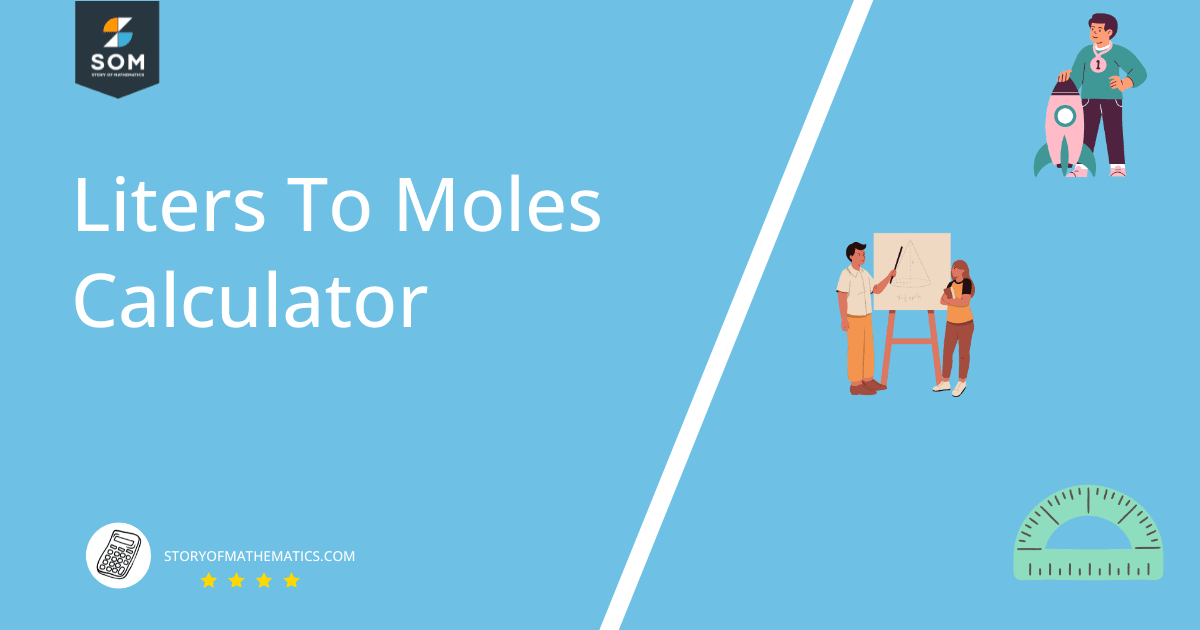JUMP TO TOPIC
Liters to Moles Calculator + Online Solver With Free Steps
The Liters to Moles Calculator is used to convert liters to moles. It can also perform other unit conversions. Unit conversions are essential as they are usually involved in solving numerical problems. It takes the value and the unit to be converted as input. It also needs the unit the user wants to convert the input unit into.
It outputs the resulting value in the units according to the user’s requirement. The calculator also gives additional unit conversions in which all the possible unit values for the particular input are shown. It also provides the basic unit dimensions which play a vital part in physics.
In addition, the calculator also compares the resulting unit value with the amount concentration and the dissociation constant.
Although the calculator’s name is Liters to Moles Calculator, it provides many unit conversions along with the change in prefixes such as milli (m), nano (n), mega (M), kilo (k), peta (P), giga (G), hecto (h), or tera (T).

What Is Liters to Moles Calculator?
The Liters to Moles Calculator is an online tool that is used to convert liters into moles. It can also carry out other unit conversions such as kilograms to grams, meters to millimeters, feet to inches, and vice versa.
Unit Conversions are crucial in all fields of sciences. If the units are not by the requirement of the mathematical formulas, the answers obtained will be incorrect, leading to corrupt results.
The calculator also provides additional quantities related to the input data. For example, if a mass is entered, the calculator computes the weight and volume.
How To Use the Liters to Moles Calculator
The user can use the Liters to Moles Calculator by following the steps given below.
Step 1
The user must first enter the unit, which needs to be converted into the calculator’s input window. It should be entered in the block titled; “Unit 1”.
Along with the unit, a numerical value needs to be entered, which the calculator will convert into the required department.
For the default example, the numerical value and the unit entered, which is to be converted, is 50 mmol/L.
Step 2
The user must now enter the unit in which the user requires the resulting value. It should be entered against the block labeled; “Unit 2”.
The unit in which the default example needs to be converted is mol/mL.
Step 3
The user must now press the “Submit” button for the calculator to process both the entered units and provide results accordingly.
Output
The calculator shows the output in the following seven windows as follows.
Input Interpretation
The calculator interprets the input and shows it in this window. For the default example, it prints “convert 50 mmol/L (millimoles per liters) to moles per milliliters”.
Result
The calculator shows the unit conversion required by the user in this window. For the default example, 50 mmol/L is equal to $5 × 10^{-5}$ mol/mL.
Additional Conversions
Additional Unit Conversions are also computed by the calculator, which the user may require. It can also provide exact form and more digits if the result is a non-terminating decimal value.
By pressing on More Digits and Exact Form, more digits in the additional conversions can be obtained.
For the default example, the additional conversions for 50 mmol/L are 50 mM (millimolar), 0.05 M (molar), 50 $mol/m^3$ (moles per cubic meters), 0.05 $mol/dm^3$ (moles per cubic decimeter) and 5 mmol/dL (millimoles per deciliters).
Comparisons as Amount Concentrations
The calculator also compares some amount concentrations with the output unit conversion.
For the default example, it compares the result with a molar concentration of household vinegar and the typical molar concentration of glucose in the blood.
Comparison of Dissociation Constant
The calculator also compares the result with the dissociation constant of vitamin C.
For the default example, the multiplication of 550 with the dissociation constant of vitamin C is approximately equal to $9.1 × 10^{-5}$ mol/L.
Interpretations
The interpretations window shows the comparisons the calculator has performed. It displays “amount concentration” and “dissociation constant” in the default example.
Basic Unit Dimensions
The calculator also gives the basic unit dimensions of the input quantity.
The primary unit dimensions are temperature, mass, time, amount of matter, electric current, length, and amount of light.
For the default example, the calculator gives the basic unit dimensions as ${[length]}^{-3}[amount]$.
Solved Example
The following example is solved through the Liters to Moles Calculator.
Example 1
Convert 10 grams into kilograms. Also, provide additional unit conversions of the weight of a body in millinewtons, dynes, ponds, and pounds force.
Find the volume of water. Also, show the comparison of mass with an empty 12-ounce aluminum soda can, the mass of a pencil, and the mass of a US quarter.
Solution
The user must first enter 10 g in the “Unit 1” block and “kg” in the “Unit 2” block. After pressing the “Submit” button, the calculator shows the Input Interpretation as “convert 10 grams to kilograms”.
The calculator computes the result as “0.01 kg (kilograms)”. It compares the mass by multiplying 0.67 with the mass of an empty 12-ounce aluminum soda can, which approximately equals 15 grams.
The mass of the pencil approximately equals 10 grams and multiplying the mass of a US quarter by 1.8 is 0.0125 lb.
The calculator shows the Interpretation as “mass.” In the Corresponding Quantities Window, the weight of a body is calculated by using the mathematical formula:
W=mg
The calculator computes the weight in millinewtons, dynes, ponds, and pounds. With mass equals 10 grams, the weight is 98 m.N, 9807 dynes, 10 ponds, and 0.022 lbf.
The volume of water is also calculated by dividing mass by the density of water.
By taking the mass of water as 10 grams and the conventional water density to be 1000 kilograms per meter cubed, the volume of water is 10 mL (milliliters) and 10 $cm^3$ (cubic centimeters).
